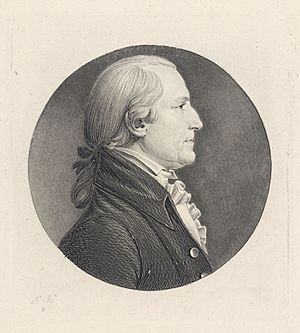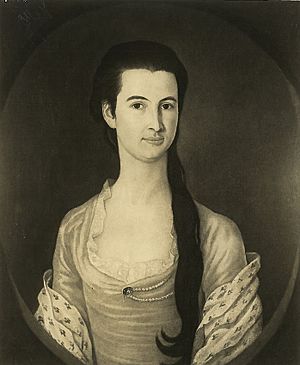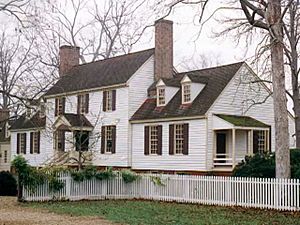St. George Tucker facts for kids
Quick facts for kids
St. George Tucker
|
|
|---|---|

Portrait by Charles Balthazar Julien Févret de Saint-Mémin.
|
|
| Judge of the United States District Court for the Eastern District of Virginia | |
| In office February 4, 1819 – June 30, 1825 |
|
| Appointed by | operation of law |
| Preceded by | Seat established by 3 Stat. 478 |
| Succeeded by | George Hay |
| Judge of the United States District Court for the District of Virginia | |
| In office January 19, 1813 – February 4, 1819 |
|
| Appointed by | James Madison |
| Preceded by | John Tyler Sr. |
| Succeeded by | Seat abolished |
| Justice of the Virginia Supreme Court | |
| In office April 11, 1804 – April 2, 1811 |
|
| Personal details | |
| Born |
St. George Tucker
July 10, 1752 Port Royal, Bermuda |
| Died | November 10, 1827 (aged 75) Warminster, Virginia |
| Political party | Democratic-Republican |
| Relations | Theodorick Bland |
| Children | Henry St. George Tucker Sr. Nathaniel Beverley Tucker John Randolph (step child) |
| Parent |
|
| Relatives | Thomas Tudor Tucker Henry Tucker George Tucker John Randolph Tucker Nathaniel Beverley Tucker Henry St. George Tucker III |
| Education | College of William & Mary |
| Signature | |
St. George Tucker (born July 10, 1752 – died November 10, 1827) was an important American lawyer, soldier, and teacher. He was born in Bermuda. He taught law at the College of William & Mary in Virginia. He believed lawyers needed a strong education. So, he made the requirements for a law degree at the college tougher.
After the American Revolutionary War, Tucker supported ending slavery slowly. He even suggested a plan to the Virginia government in 1796. He also wrote an American version of a famous law book called Commentaries on the Laws of England by Blackstone. This book became very helpful for many American lawyers. Later, President James Madison made Tucker a judge. Many of Tucker's family members also became famous lawyers, teachers, and politicians.
Contents
Early Life and Education
St. George Tucker was born in Bermuda in 1752. His parents were Anne Butterfield and Colonel Henry Tucker. His family was well-known in Bermuda. His older brother, Thomas Tudor Tucker, moved to Virginia and then to South Carolina. Another brother, Henry Tucker, became a leader in Bermuda.
When he was 19, Tucker moved to Virginia in 1772. He wanted to study law with a famous lawyer named George Wythe. Tucker went to the College of William & Mary. After six months, he took private law lessons from Wythe. He became a lawyer on April 4, 1774, just before the American Revolutionary War began.
As problems with England grew, many courts in Virginia closed. Tucker went back to Bermuda to practice law, but business was slow. So, he joined his father and brother in a business. They smuggled goods between the West Indies and the American colonies.
Serving in the Military
During the American Revolutionary War, Tucker became a major in the Virginia army. He fought bravely in the Battle of Guilford Court House in North Carolina. He was even wounded in the leg during this battle. After he got better, he became a lieutenant colonel.
At the Siege of Yorktown in 1781, Tucker was wounded again by an exploding shell. He was helping Governor and General Thomas Nelson Jr. talk with his French allies.
Becoming a Lawyer and Legal Expert
After the war ended in 1782, Tucker started his law career in Virginia. He began working in Chesterfield County in 1783. He was soon allowed to practice law in higher courts in Virginia.
Tucker quickly gained attention from judges and the government. In 1782, he spoke in a case called Commonwealth v. Caton. This was one of the first American cases to talk about whether courts could review laws. Tucker argued that courts should have this power.
In 1785, Tucker wrote a paper suggesting that American states should have a common business policy. This led to him being chosen as a delegate for Virginia at the Annapolis Convention. He attended with important figures like James Madison.
Teaching Law at William & Mary
Tucker became a member of the College of William & Mary's Board of Visitors in 1782. He worked to protect the college's courses. In 1789, he became the college's rector. When George Wythe retired in 1790, Tucker was named the new professor of law.
Tucker used William Blackstone's Commentaries on the Laws of England as his main textbook. But he also taught how American laws were different from English laws. He added lessons on the United States government. He told his students that American laws were more important than old English law books. Tucker also talked about important topics like ending slavery in his classes.
Tucker believed that future lawyers needed a good education. He even helped students with their fees so they wouldn't drop out. His reputation grew, and students from other states and even other countries came to study with him.
Tucker taught his classes from his home in Williamsburg. This way, he could use his large library of law books. In 1801, the college decided that all professors had to teach on campus. Tucker tried to follow this rule, but then went back to teaching at home. In 1803, the college made new rules for professors, including checking on students. Tucker felt these new rules showed "perfect contempt" for professors. So, he resigned in March 1804.
Serving as a Judge
Virginia State Courts
In 1788, Tucker was chosen to be a judge on the General Court of Virginia in Richmond. He served there until 1803. While on this court, he tried to improve Virginia's legal system. He suggested new laws to change how courts worked and how juries were chosen. However, the Virginia government did not pass his ideas.
In 1804, Tucker was elected to the Virginia Supreme Court of Appeals. He was known for writing very detailed opinions that looked at every part of a case. He often wrote a single opinion for the court instead of separate ones.
One important case he ruled on was Hudgins v. Wright in 1806. This was a "freedom suit." A woman named Jackey Wright and her children sued for their freedom. Their former owner, George Wythe, had ruled they should be free because of their American Indian ancestors. Virginia had ended Indian slavery earlier.
Tucker and the other judges on the appeals court agreed that the Wrights should be free. They based their decision on the Wrights' Indian ancestry. They also noted that the person who appealed the case could not prove the Wrights had African ancestors.
Tucker resigned from the Virginia Supreme Court in 1811. He was having disagreements with another judge and was frustrated with some new rules from the government.
Federal Judge Service
After leaving the state court, Tucker returned to private law practice. In 1813, President James Madison nominated him to be a judge for the United States District Court for the District of Virginia. Tucker was unsure, but friends convinced him to accept. He became a federal judge on January 19, 1813.
In 1819, he was moved to the United States District Court for the Eastern District of Virginia. He served until June 1825, when he resigned due to his failing health. As a federal judge, Tucker also worked with Chief Justice John Marshall on a higher court in Richmond.
Even though Tucker was a respected legal thinker, he was never appointed to the Supreme Court of the United States. This was likely because two other Virginians were already serving on that court.
Family Life
In 1778, Tucker married Frances (Bland) Randolph. She was a wealthy widow with three young sons, including John. Tucker moved to her plantation in Chesterfield County. Tucker and Frances had three sons and two daughters together. Frances passed away in 1788 after giving birth to their youngest daughter.
After Frances died, Tucker moved to a house in Williamsburg. This house is now part of Colonial Williamsburg and is called the St. George Tucker House. In 1791, Tucker married Leila Skipwith Carter, another widow. Leila and her two children joined Tucker and his children in Williamsburg.
After Tucker retired from being a judge in 1825, he and Leila split their time between Williamsburg and a cottage on the Edgewood estate. Tucker had a stroke in 1827 and passed away six weeks later on November 10, 1827.
Important Family Members
St. George Tucker was the first of many family members who would become important lawyers and politicians in Virginia.
- His step-son, John Randolph of Roanoke (1773–1833), was a powerful leader in the U.S. House of Representatives. He also served as a U.S. Senator and an ambassador to Russia.
- His son, Henry St. George Tucker Sr. (1780–1848), served in the state government and the U.S. House of Representatives. He also became President of the Virginia Supreme Court of Appeals.
- His second son, Nathaniel Beverley Tucker (1784–1851), became a law professor at William & Mary. He wrote books about politics and literature.
- His grandson, John Randolph Tucker (1823–1897), was Virginia's attorney general. He also served in the U.S. House of Representatives and was a law school dean.
- His great-grandson, Henry St. George Tucker III (1853–1932), also served in the U.S. House of Representatives and was a law school dean.
Idea to End Slavery
After being a judge for eight years, Tucker wrote a paper called A Dissertation on Slavery. This paper suggested a plan for slowly ending slavery in Virginia. He sent it to the General Assembly of Virginia in 1796. He believed ending slavery was very important for Virginia's future.
Tucker did a lot of research for his paper. He wrote to legal experts in northern states to learn how they were ending slavery. His paper was one of the first detailed studies of slavery's history and laws in the American colonies.
Why Tucker Opposed Slavery
Tucker's paper pointed out that many enslaved people in Virginia had already been freed. He said Virginia had more "free negroes" than several New England states where slavery was ending. He argued that slavery was wrong and went against the idea of a free country:
- He wrote that America had been a land of hope for Europeans. But for millions of Africans, it had been a "vale of death."
- He said that while Americans fought for their own freedom, they were forcing others into a much harsher slavery.
- He explained that slavery took away basic rights like personal freedom and owning property. He felt this was completely against the idea of a democracy.
Challenges to His Plan
Tucker knew his plan would face strong opposition. Many wealthy Virginians owned enslaved people, and ending slavery would mean losing a lot of their wealth. It would also reduce taxable property in the state. People were also worried about how society would change if enslaved people were freed. Some feared that freed people would not want to work on plantations.
Tucker's Plan for Freedom
Tucker suggested a slow process to end slavery. This was similar to what some northern states were doing. His plan included:
- All girls born to enslaved mothers after the plan started would be born free.
- These freed women would work for their former master's family until age 28. Then they would receive some money, clothes, and blankets.
- Their children would also be free but would work until age 21.
- Black people in Virginia would not be allowed to hold public office or own land. They could only lease land for a limited time.
- They would not be allowed to own weapons, except in special cases approved by the government.
- Black people could not marry outside their race. They could not be lawyers or jurors. They could only be witnesses against other black people in court.
- They would not be allowed to write wills or own property in certain ways.
How People Reacted
The Virginia government rejected Tucker's plan. One supporter noted that some lawmakers voted against even discussing it. Tucker was very disappointed. He continued to talk about his ideas and share his paper, but he didn't make any more official proposals.
Tucker admitted that he made some compromises in his plan to try and get it passed. He also said he had his own prejudices. While he didn't want to force black people out of Virginia, he hoped his plan would make them want to leave on their own. He suggested places like Louisiana as possible new homes.
Even with its flaws, Tucker's Dissertation is seen as very important today. It was the first real effort by a Southerner to try and end slavery in his state. Scholars say Tucker was brave to explore this difficult issue.
Tucker's Version of Blackstone's Law Book
When Tucker taught law at William & Mary, he used William Blackstone's Commentaries on the Laws of England. This book was great for learning about English law. However, Tucker felt it didn't cover new American laws. Also, Blackstone's book seemed to favor the power of the king, which wasn't good for American students learning about their new government.
So, Tucker added his own notes to his copy of Blackstone's book. He read these notes to his classes. He also added lessons about Virginia and U.S. federal law. He compared the American political system to the British one.
In 1795, friends encouraged Tucker to publish his work. He found a publisher in Philadelphia. "Tucker's Blackstone" was published in five volumes. Each volume had Blackstone's original text with Tucker's notes. It also had an appendix with Tucker's lectures and writings on American law.
Tucker's Blackstone sold very well. It quickly became the most important law book in early 19th-century America. Lawyers often quoted it in court. The Supreme Court of the United States itself referred to Tucker's Blackstone in over forty important cases. Even today, lawyers and scholars use this book to understand how Americans viewed English and American law after the United States became independent.
Works by St. George Tucker
- Blackstone's Commentaries : with notes of reference to the constitution and laws, of the federal government of the United States, and of the Commonwealth of Virginia : with an appendix to each volume, containing short tracts upon such subjects as appeared necessary to form a connected view of the laws of Virginia as a member of the federal union, 5 vols. (1803)
- A dissertation on slavery : with a proposal for the gradual abolition of it, in the state of Virginia, (1796)
- View of the Constitution of the United States with Selected Writings (1803)



